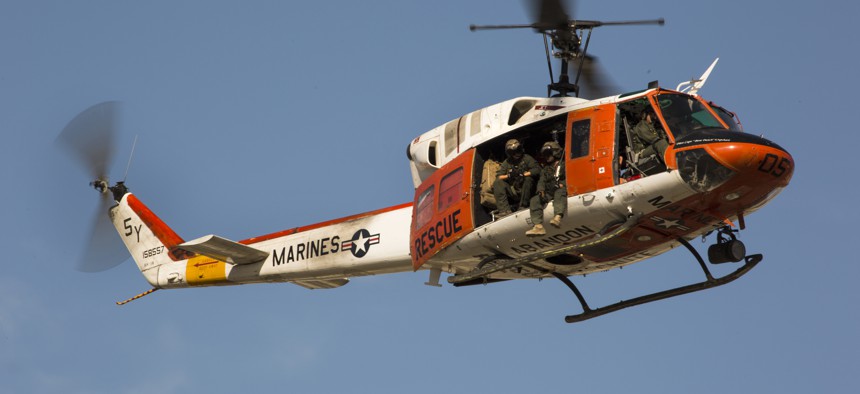
An HH-1N “Huey” flies overhead to deliver a ceremonial sword during the annual cake cutting ceremony at Marine Corps Air Station Yuma, Ariz., Nov. 10, 2016 ance Cpl. Christian Oliver Cachola
Unmanned Hueys Are Coming
Remote-controlled helicopters for resupply enter new phase of development.
In the future, when Marines at forward operating bases call for resupply, the Huey that greets them may be empty. On Thursday, Aurora Flight Sciences announced that they would be putting their Tactical Autonomous Aerial Logistics System, or TALOS, unmanned helicopter piloting system on a UH-1H helicopter, part of the Navy’s Autonomous Aerial Cargo/Utility System, or ACCUS, program. ACCUS seeks an open-architecture system that can be retrofitted onto any helicopter to allow for easy unmanned flying. An operator with just 15 minutes of training is supposed to be able to steer the helicopter via a tablet PC.
Aurora has already tested their TALOS technology on a Boeing H-6U Unmanned Little Bird and on three manned Bell 206 aircraft.
“The arrival of a Huey as our third test platform frames a key point for future customers: the TALOS system is platform-agnostic. You’re not buying a new fleet of helicopters, you’re buying a capability set for your current fleet,” said John Wissler, who runs Aurora’s R&D center, in a press release. “TALOS is not an aircraft, nor is it a robot flying an aircraft –TALOS is transferrable intelligence designed with both manned and unmanned aircraft requirements in mind.”
The unmanned helicopters use cameras as well as electro-optical, infrared, and light emitting, distance and ranging (LIDAR) sensors to detect obstacles and fly around them. In 2014, Adm. Matt Klunder, then the head of the Office of Naval Research, or ONR, described an ACCUS demonstration .
“I stood right next to the 20-year-old lance corporal. I touched the button. It is literally a one-touch app,” Klunder said. ACCUS has been demonstrated on the K-Max and Little Bird.
The K-Max unmanned helicopter was the first unmanned helicopter to see combat and flew 600 unmanned missions and delivered more than two million pounds of cargo for the Marines by 2013.
ONR launched the AACUS program in 2012 and chose Aurora to continue on to phase II in 2014. In July, the company received funding for phase III. Aurora is also the prime contractor on the Defense Advanced Research Project Agency’s VTOL program .
NEXT STORY: Yes, Big Data Did Triumph on Election Day




